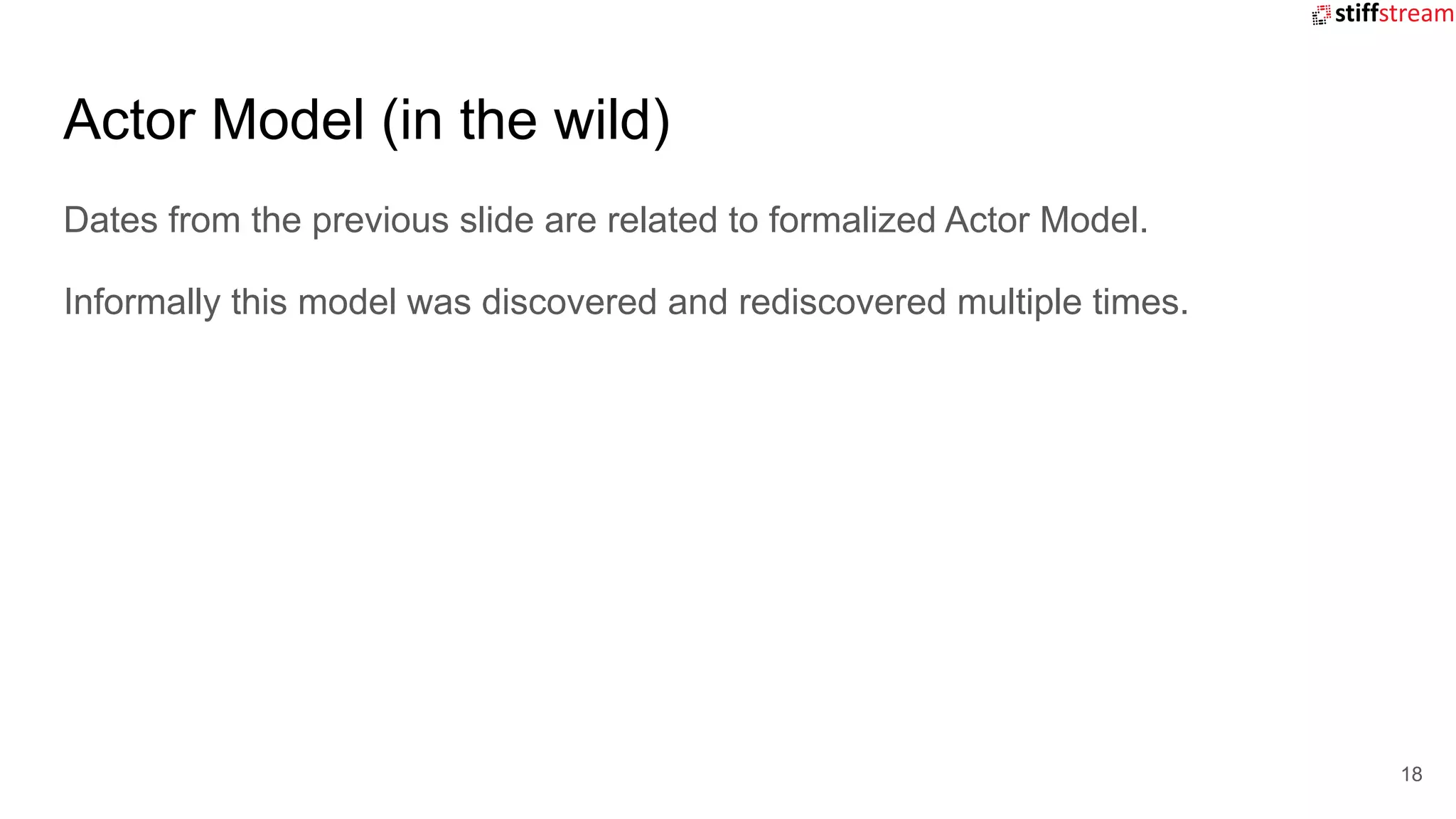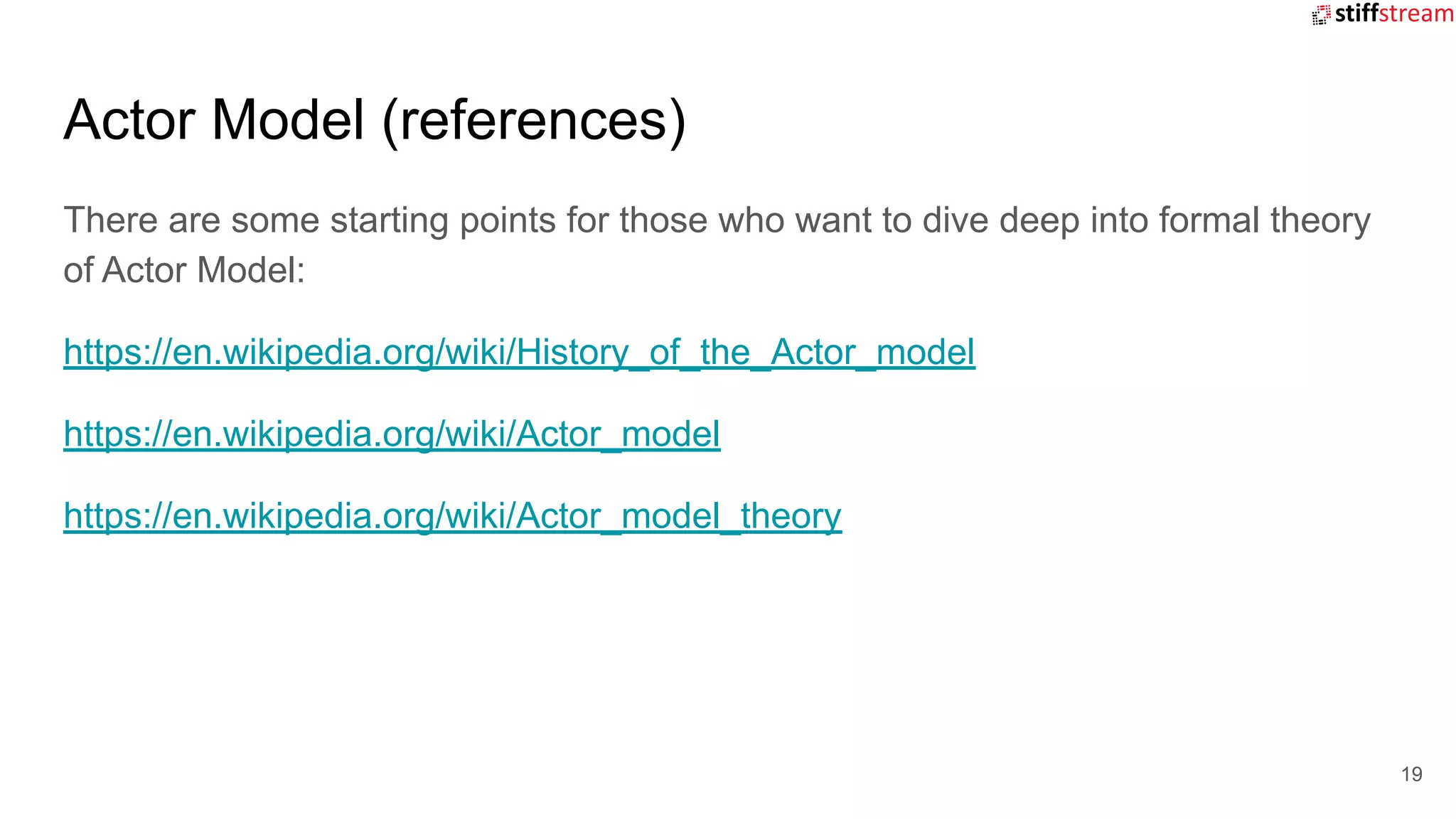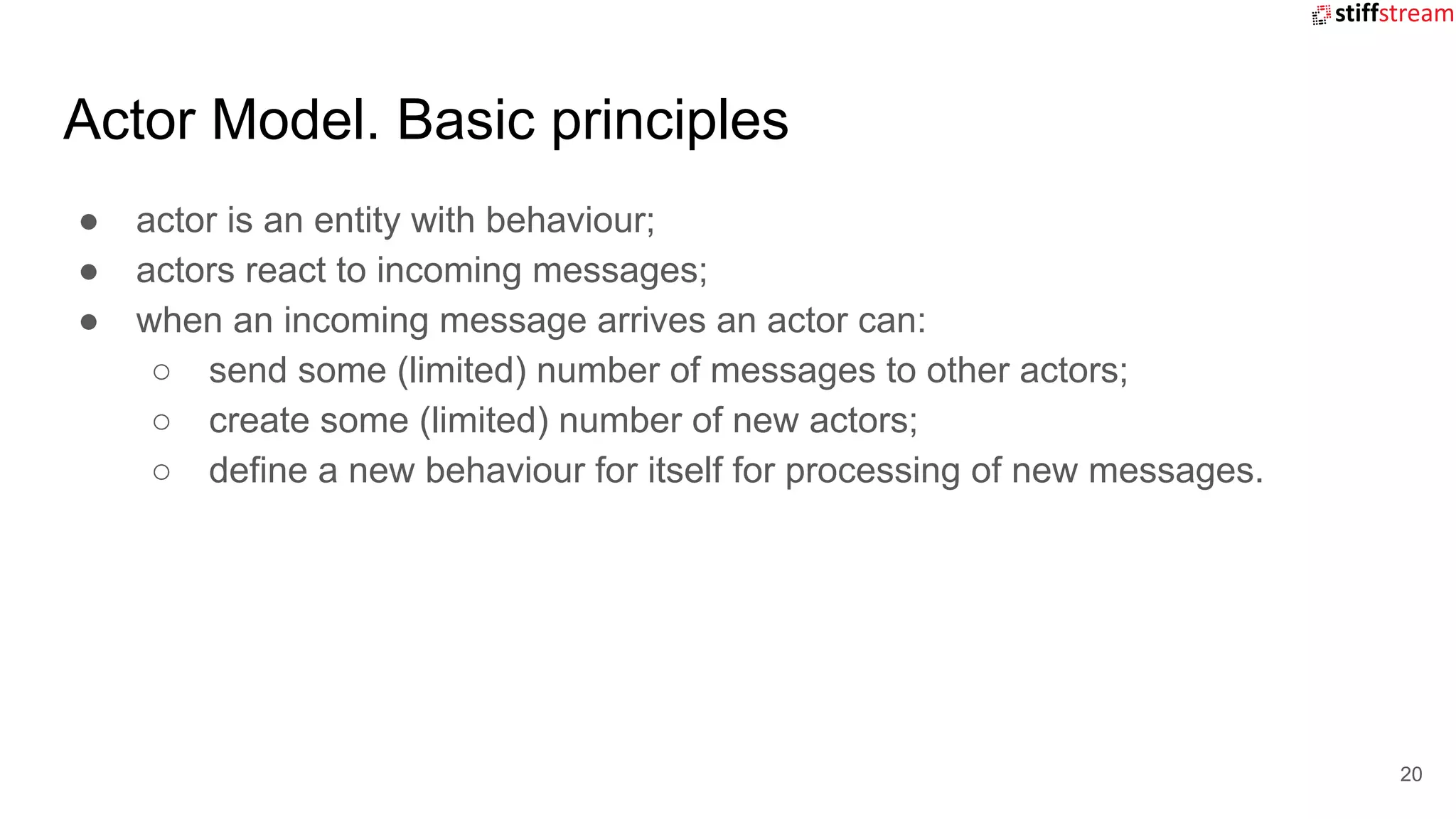The document discusses the actor model in the context of C++, emphasizing its relevance in multithreading and concurrent computing, while providing an overview of various C++ frameworks that implement this model. It highlights the challenges of traditional multithreading and advocates for the actor model as a simpler and more effective approach to handle messaging and state management. Historical context about the actor model's evolution and successful implementations like Erlang and Akka is also provided.



























![Today's icons: Erlang (ping-pong example)
-module(tut15).
-export([start/0, ping/2, pong/0]).
ping(0, Pong_PID) ->
Pong_PID ! finished,
io:format("ping finished~n", []);
ping(N, Pong_PID) ->
Pong_PID ! {ping, self()},
receive
pong ->
io:format("Ping received pong~n", [])
end,
ping(N - 1, Pong_PID).
28
pong() ->
receive
finished ->
io:format("Pong finished~n", []);
{ping, Ping_PID} ->
io:format("Pong received ping~n", []),
Ping_PID ! pong,
pong()
end.
start() ->
Pong_PID = spawn(tut15, pong, []),
spawn(tut15, ping, [3, Pong_PID]).](https://image.slidesharecdn.com/actormodelandcppwhatwhyandhowmarch2020-200304112302/75/Actor-Model-and-C-what-why-and-how-March-2020-Edition-28-2048.jpg)


![Today's icons: Akka (ping-pong example)
import akka.actor._
case object PingMessage
case object PongMessage
case object StartMessage
case object StopMessage
class Ping(pong: ActorRef) extends Actor {
var count = 0
def incrementAndPrint { count += 1; println("ping") }
def receive = {
case StartMessage =>
incrementAndPrint
pong ! PingMessage
case PongMessage =>
incrementAndPrint
if (count > 99) {
sender ! StopMessage
println("ping stopped")
context.stop(self)
} else {
sender ! PingMessage
}
31
}
}
class Pong extends Actor {
def receive = {
case PingMessage =>
println(" pong")
sender ! PongMessage
case StopMessage =>
println("pong stopped")
context.stop(self)
}
}
object PingPongTest extends App {
val system = ActorSystem("PingPongSystem")
val pong = system.actorOf(Props[Pong], name = "pong")
val ping = system.actorOf(Props(new Ping(pong)), name = "ping")
// start them going
ping ! StartMessage
}
http://alvinalexander.com/scala/scala-akka-actors-ping-pong-simple-example](https://image.slidesharecdn.com/actormodelandcppwhatwhyandhowmarch2020-200304112302/75/Actor-Model-and-C-what-why-and-how-March-2020-Edition-31-2048.jpg)












![QP/C++ (code example: main.cpp)
#include "qpcpp.h"
#include "bsp.h"
#include "blinky.h"
int main() {
static QEvt const *blinkyQSto[10]; // Event queue storage for Blinky
BSP_init(); // initialize the Board Support Package
QF::init(); // initialize the framework and the underlying RT kernel
// instantiate and start the active objects...
AO_Blinky->start(1U, // priority
blinkyQSto, Q_DIM(blinkyQSto), // event queue
(void *)0, 0U); // stack (unused)
return QF::run(); // run the QF application
}
44](https://image.slidesharecdn.com/actormodelandcppwhatwhyandhowmarch2020-200304112302/75/Actor-Model-and-C-what-why-and-how-March-2020-Edition-44-2048.jpg)




![Just::Thread Pro: Actors Edition (ping-pong)
#include <jss/actor.hpp>
#include <iostream>
#include <thread>
int main()
{
struct pingpong {
jss::actor_ref sender;
pingpong(jss::actor_ref sender_): sender(sender_) {}
};
jss::actor pp1(
[]{
for(;;)
{
jss::actor::receive().match<pingpong>(
[](pingpong p){
std::cout<<"pingn";
p.sender.send(pingpong(jss::actor::self()));
});
}
});
49
jss::actor pp2(
[]{
for(;;)
{
jss::actor::receive().match<pingpong>(
[](pingpong p){
std::cout<<"pongn";
p.sender.send(pingpong(jss::actor::self()));
});
}
});
pp1.send(pingpong(pp2));
std::this_thread::sleep_for(std::chrono::seconds(2));
pp1.stop();
pp2.stop();
}](https://image.slidesharecdn.com/actormodelandcppwhatwhyandhowmarch2020-200304112302/75/Actor-Model-and-C-what-why-and-how-March-2020-Edition-49-2048.jpg)



 -> error { return
fixed_stack_errc::push_to_full; },
[=](pop_atom) -> int {
auto result = data_.back();
data_.pop_back();
become(filled_);
return result;
});
filled_.assign( //
[=](push_atom, int what) {
data_.push_back(what);
if (data_.size() == size_) become(full_);
},
[=](pop_atom) -> int {
auto result = data_.back();
data_.pop_back();
if (data_.empty()) become(empty_);
return result;
}); 53
empty_.assign( //
[=](push_atom, int what) {
data_.push_back(what);
become(filled_);
},
[=](pop_atom) -> error { return
fixed_stack_errc::pop_from_empty; });
}
behavior make_behavior() override {
assert(size_ < 2);
return empty_;
}
private:
size_t size_;
std::vector<int> data_;
behavior full_;
behavior filled_;
behavior empty_;
};](https://image.slidesharecdn.com/actormodelandcppwhatwhyandhowmarch2020-200304112302/75/Actor-Model-and-C-what-why-and-how-March-2020-Edition-53-2048.jpg)
 { aout(self) << x << " "; },
[&](const error&) { stack_empty = true; });
}
aout(self) << "}" << endl;
self->send_exit(st, exit_reason::user_shutdown);
}
} // namespace
CAF_MAIN()
54](https://image.slidesharecdn.com/actormodelandcppwhatwhyandhowmarch2020-200304112302/75/Actor-Model-and-C-what-why-and-how-March-2020-Edition-54-2048.jpg)






![SObjectizer-5 (blinking_led, 2)
blinking_led( context_t ctx ) : so_5::agent_t{ ctx }
{
this >>= off;
off.just_switch_to< turn_on_off >( blinking );
blinking.just_switch_to< turn_on_off >( off );
blink_on
.on_enter( []{ std::cout << "ON" << std::endl; } )
.on_exit( []{ std::cout << "off" << std::endl; } )
.time_limit( std::chrono::milliseconds{1250}, blink_off );
blink_off
.time_limit( std::chrono::milliseconds{750}, blink_on );
}
};
61](https://image.slidesharecdn.com/actormodelandcppwhatwhyandhowmarch2020-200304112302/75/Actor-Model-and-C-what-why-and-how-March-2020-Edition-61-2048.jpg)
 {
auto m = env.introduce_coop( []( so_5::coop_t & coop ) {
return coop.make_agent< blinking_led >()->so_direct_mbox();
} );
std::cout << "Turn blinking on for 10s" << std::endl;
so_5::send< blinking_led::turn_on_off >( m );
std::this_thread::sleep_for( 10s );
std::cout << "Turn blinking off for 5s" << std::endl;
so_5::send< blinking_led::turn_on_off >( m );
std::this_thread::sleep_for( 5s );
std::cout << "Turn blinking on for 5s" << std::endl;
so_5::send< blinking_led::turn_on_off >( m );
std::this_thread::sleep_for( 5s );
std::cout << "Stopping..." << std::endl;
env.stop();
} );
}
62](https://image.slidesharecdn.com/actormodelandcppwhatwhyandhowmarch2020-200304112302/75/Actor-Model-and-C-what-why-and-how-March-2020-Edition-62-2048.jpg)







 {
so_5::mbox_t stack = env.introduce_coop( []( so_5::coop_t & coop ) {
return coop.make_agent<fixed_stack>( 5u )->so_direct_mbox();
} );
// Fill stack.
for( int i = 0; i < 10; ++i )
so_5::send< fixed_stack::push >( stack, i );
// Drain stack.
std::cout << "stack { ";
for(;;) {
const auto r = fixed_stack::pop_request::ask_value( stack, 10s );
if( auto * v = std::get_if<fixed_stack::value>( &r ) )
std::cout << v->m_val << " ";
else break;
}
std::cout << "}" << std::endl;
env.stop();
} );
return 0;
}
70](https://image.slidesharecdn.com/actormodelandcppwhatwhyandhowmarch2020-200304112302/75/Actor-Model-and-C-what-why-and-how-March-2020-Edition-70-2048.jpg)
